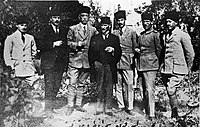
Back الحركة التركية الوطنية Arabic Türk Milli Hərəkatı Azerbaijani Төрөк милли хәрәкәте Bashkir Турэцкі нацыянальны рух BE-X-OLD Турско национално движение Bulgarian Türkische Nationalbewegung German Τουρκικό Εθνικό Κίνημα Greek Turka Nacia Movado Esperanto Movimiento Nacional Turco Spanish Türgi rahvuslik liikumine Estonian
This article needs additional citations for verification. (July 2014) |
| Turkish National Movement | |
|---|---|
| Türk Ulusal Hareketi | |
 Prominent nationalists at the Sivas Congress. Left to right: Ahmet Muzaffer (Kılıç), Rauf Bey (Orbay), Bekir Sami (Kunduh), Mustafa Kemal (Atatürk), Ruşen Eşref (Ünaydın), Cemil Cahit (Toydemir), Cevat Abbas (Gürer). | |
| Leader | Mustafa Kemal Pasha |
| Dates of operation | June 22, 1919–October 29, 1923 |
| Country | |
| Allegiance | |
| Motives | Opposition to the partition of the Ottoman Empire |
| Headquarters | Ankara |
| Active regions | Anatolia, Thrace |
| Ideology | Turkish nationalism |
| Allies | |
| Opponents | |
| Battles and wars | Turkish War of Independence |
The Turkish National Movement (Turkish: Millî Hareket), also known as the Anatolian Movement (Turkish: Anadolu Hareketi), the Nationalist Movement (Turkish: Milliyetçi Hareket), and the Kemalists (Turkish: Kemalîler or Kemalistler), included political and military activities of the Turkish revolutionaries that resulted in the creation and shaping of the modern Republic of Turkey, as a consequence of the defeat of the Ottoman Empire in World War I and the subsequent occupation of Constantinople and partitioning of the Ottoman Empire by the Allies under the terms of the Armistice of Mudros. The Turkish revolutionaries rebelled against this partitioning and against the Treaty of Sèvres, signed in 1920 by the Ottoman government, which partitioned portions of Anatolia itself.
This establishment of an alliance of Turkish revolutionaries during the partitioning resulted in the Turkish War of Independence, the genocides of the Anatolian native nations, the abolition of the Ottoman sultanate on 1 November 1922 and the declaration of the Republic of Turkey on 29 October 1923. The movement organized itself into the Association for the Defence of National Rights of Anatolia and Rumeli, which eventually declared that the only source of governance for the Turkish people would be the Grand National Assembly of Turkey.
The movement was created in 1919 through a series of agreements and conferences throughout Anatolia and Thrace. The process was aimed to unite independent movements around the country to build a common voice and is attributed to Mustafa Kemal Atatürk,[5] as he was the primary spokesperson, public figure, and military leader of the movement.
- ^ The Place of the Turkish Independence War in the American Press (1918–1923) by Bülent Bilmez: "...the occupation of western Turkey by the Greek armies under the control of the Allied Powers, the discord among them was evident and publicly known. As the Italians were against this occupation from the beginning, and started "secretly" helping the Kemalists, this conflict among the Allied Powers, and the Italian support for the Kemalists were reported regularly by the American press.
- ^ Sforza, Diario, November 28, 1920, 61/ David Lloyd George, The Truth about the Peace Treaties, v. 2 (Gollancz, London: 1938), pp. 1348–1349 / Michael Smith, Ionian Vision: Greece in Asia Minor, 1919–1922, University of Michigan Press, 1999.
- ^ Ζολώτα, Αναστασίου Π. (1995). Η Εθνική Τραγωδία (National Tragedy). Αθήνα, Πανεπιστήμιο Αθηνών, Τμήμα Πολιτικών (University of Athens) Επιστημών και Δημοσίας Διοικήσεως. σελίδες pp. 44–58
- ^ «ΤΑ ΦΟΒΕΡΑ ΝΤΟΚΟΥΜΕΝΤΑ – ΣΑΓΓΑΡΙΟΣ ΕΠΟΠΟΙΪΑ ΚΑΙ ΚΑΤΑΡΕΥΣΗ ΣΤΗΝ ΜΙΚΡΑ ΑΣΙΑ», ΔΗΜ. ΦΩΤΙΑΔΗΣ, ΕΚΔ. ΦΥΤΡΑΚΗ, ΑΘΗΝΑ, 1974
- ^ Atatürk and the Turkish Nation Source US Library of Congress
© MMXXIII Rich X Search. We shall prevail. All rights reserved. Rich X Search
